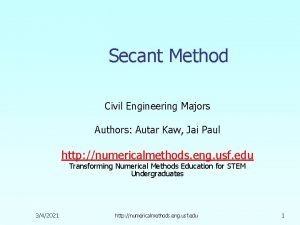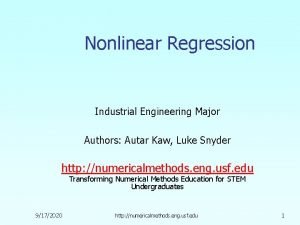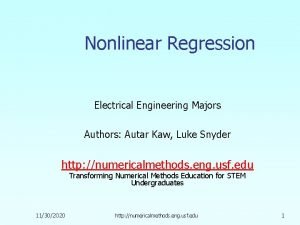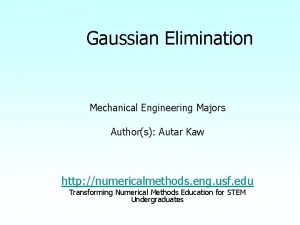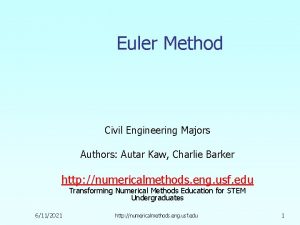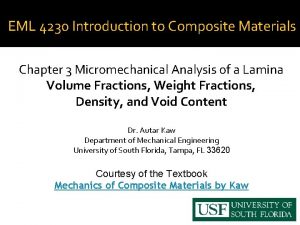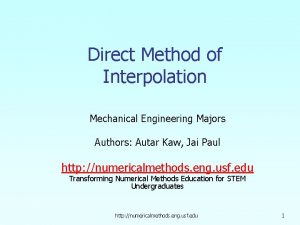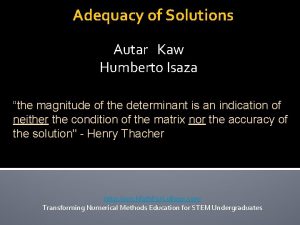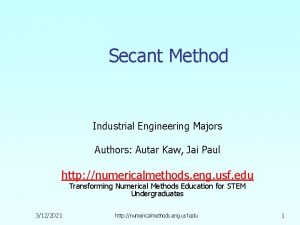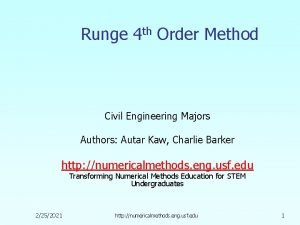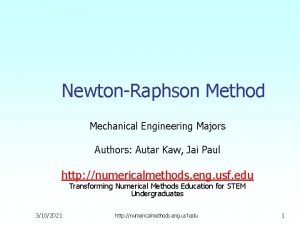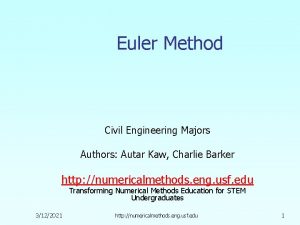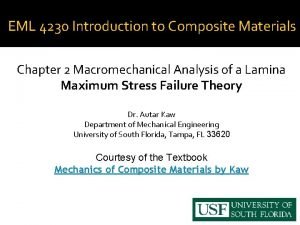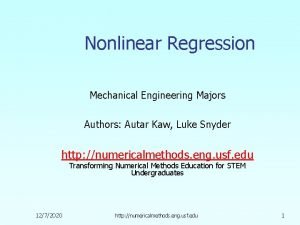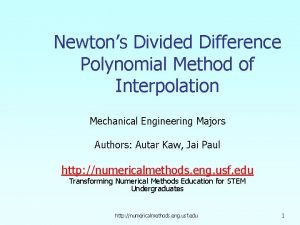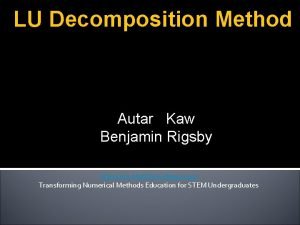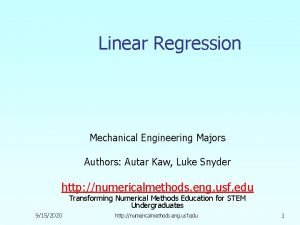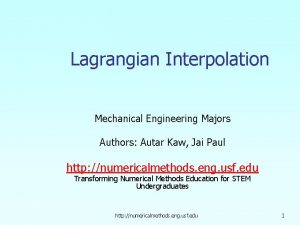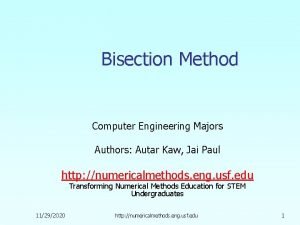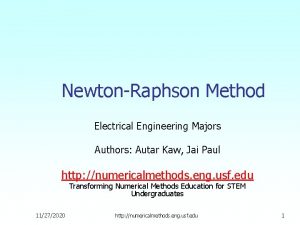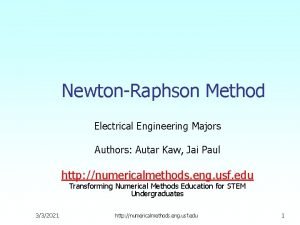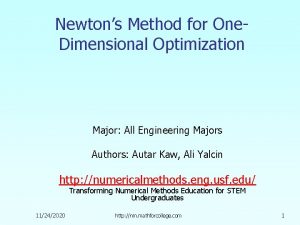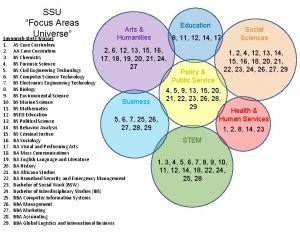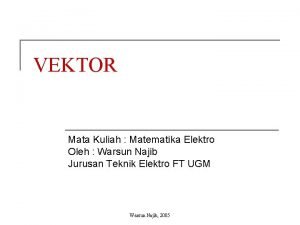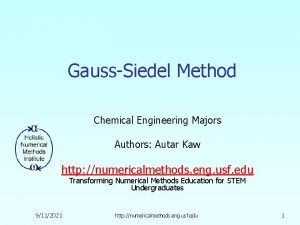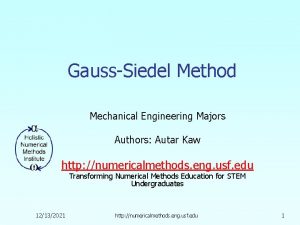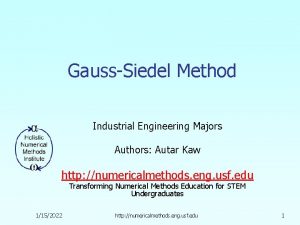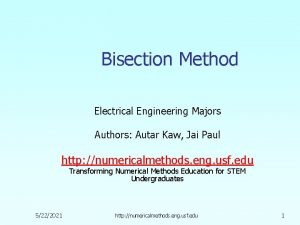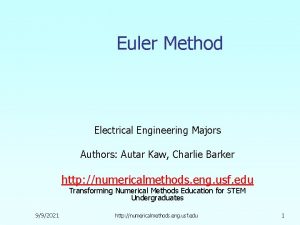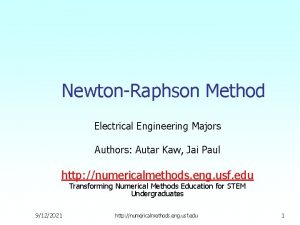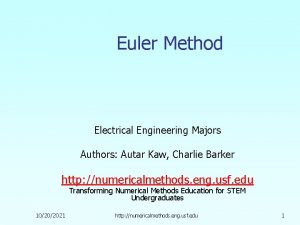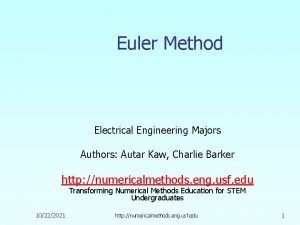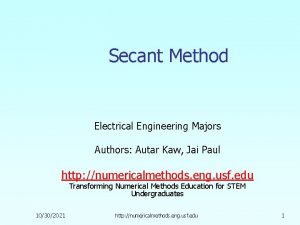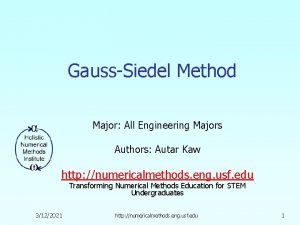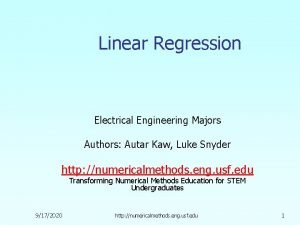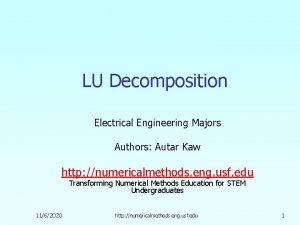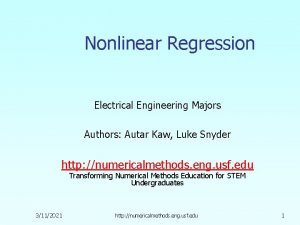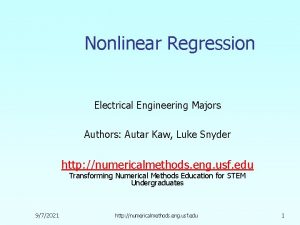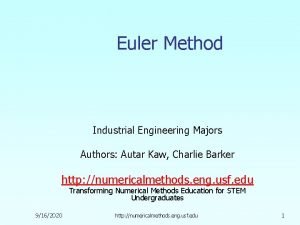GaussSiedel Method Electrical Engineering Majors Authors Autar Kaw








![Gauss-Seidel Method Solve for the unknowns Assume an initial guess for [X] Use rewritten Gauss-Seidel Method Solve for the unknowns Assume an initial guess for [X] Use rewritten](https://slidetodoc.com/presentation_image_h2/4195ecff2312e91449dc85e95e1b90f7/image-9.jpg)



































- Slides: 44

Gauss-Siedel Method Electrical Engineering Majors Authors: Autar Kaw http: //numericalmethods. eng. usf. edu Transforming Numerical Methods Education for STEM Undergraduates 5/20/2021 http: //numericalmethods. eng. usf. edu 1

Gauss-Seidel Method http: //numericalmethods. eng. usf. edu

Gauss-Seidel Method An iterative method. Basic Procedure: -Algebraically solve each linear equation for xi -Assume an initial guess solution array -Solve for each xi and repeat -Use absolute relative approximate error after each iteration to check if error is within a pre-specified tolerance. lmethods. eng. usf. edu http: //numerica

Gauss-Seidel Method Why? The Gauss-Seidel Method allows the user to control round-off error. Elimination methods such as Gaussian Elimination and LU Decomposition are prone to round-off error. Also: If the physics of the problem are understood, a close initial guess can be made, decreasing the number of iterations needed. lmethods. eng. usf. edu http: //numerica

Gauss-Seidel Method Algorithm A set of n equations and n unknowns: If: the diagonal elements are non-zero . . . Rewrite each equation solving for the corresponding unknown ex: First equation, solve for x 1 Second equation, solve for x 2 lmethods. eng. usf. edu http: //numerica

Gauss-Seidel Method Algorithm Rewriting each equation From Equation 1 From equation 2 From equation n-1 From equation n lmethods. eng. usf. edu http: //numerica

Gauss-Seidel Method Algorithm General Form of each equation lmethods. eng. usf. edu http: //numerica

Gauss-Seidel Method Algorithm General Form for any row ‘i’ How or where can this equation be used? lmethods. eng. usf. edu http: //numerica
![GaussSeidel Method Solve for the unknowns Assume an initial guess for X Use rewritten Gauss-Seidel Method Solve for the unknowns Assume an initial guess for [X] Use rewritten](https://slidetodoc.com/presentation_image_h2/4195ecff2312e91449dc85e95e1b90f7/image-9.jpg)
Gauss-Seidel Method Solve for the unknowns Assume an initial guess for [X] Use rewritten equations to solve for each value of xi. Important: Remember to use the most recent value of xi. Which means to apply values calculated to the calculations remaining in the current iteration. lmethods. eng. usf. edu http: //numerica

Gauss-Seidel Method Calculate the Absolute Relative Approximate Error So when has the answer been found? The iterations are stopped when the absolute relative approximate error is less than a prespecified tolerance for all unknowns. lmethods. eng. usf. edu http: //numerica

Example: Unbalanced three phase load Three-phase loads are common in AC systems. When the system is balanced the analysis can be simplified to a single equivalent circuit model. However, when it is unbalanced the only practical solution involves the solution of simultaneous linear equations. In a model the following equations need to be solved. Find the values of Iar , Iai , Ibr , Ibi , Icr , and Ici using the Gauss-Seidel method.

Example: Unbalanced three phase load Rewrite each equation to solve for each of the unknowns

Example: Unbalanced three phase load For iteration 1, start with an initial guess value Initial Guess:

Example: Unbalanced three phase load Substituting the guess values into the first equation Substituting the new value of Iar and the remaining guess values into the second equation

Example: Unbalanced three phase load Substituting the new values Iar , Iai , and the remaining guess values into the third equation Substituting the new values Iar , Iai , Ibr , and the remaining guess values into the fourth equation

Example: Unbalanced three phase load Substituting the new values Iar , Iai , Ibr , Ibi , and the remaining guess values into the fifth equation Substituting the new values Iar , Iai , Ibr , Ibi , Icr , and the remaining guess value into the sixth equation

Example: Unbalanced three phase load At the end of the first iteration, the solution matrix is: How accurate is the solution? Find the absolute relative approximate error using:

Example: Unbalanced three phase load Calculating the absolute relative approximate errors The maximum error after the first iteration is: 131. 98% Another iteration is needed!

Example: Unbalanced three phase load Starting with the values obtained in iteration #1 Substituting the values from Iteration 1 into the first equation

Example: Unbalanced three phase load Substituting the new value of Iar and the remaining values from Iteration 1 into the second equation Substituting the new values Iar , Iai , and the remaining values from Iteration 1 into the third equation

Example: Unbalanced three phase load Substituting the new values Iar , Iai , Ibr , and the remaining values from Iteration 1 into the fourth equation Substituting the new values Iar , Iai , Ibr , Ibi , and the remaining values From Iteration 1 into the fifth equation

Example: Unbalanced three phase load Substituting the new values Iar , Iai , Ibr , Ibi , Icr , and the remaining value from Iteration 1 into the sixth equation The solution matrix at the end of the second iteration is:

Example: Unbalanced three phase load Calculating the absolute relative approximate errors for the second iteration The maximum error after the second iteration is: 209. 24% More iterations are needed!

Example: Unbalanced three phase load Repeating more iterations, the following values are obtained Iteration 1 2 3 4 5 6 Iar Iai Ibr Ibi Icr Ici 172. 86 99. 600 126. 01 117. 25 119. 87 119. 28 − 105. 61 − 60. 073 − 76. 015 − 70. 707 − 72. 301 − 71. 936 − 67. 039 − 136. 15 − 108. 90 − 119. 62 − 115. 62 − 116. 98 − 89. 499 − 44. 299 − 62. 667 − 55. 432 − 58. 141 − 57. 216 − 62. 548 57. 259 − 10. 478 27. 658 6. 2513 18. 241 176. 71 87. 441 137. 97 109. 45 125. 49 116. 53 88. 430 73. 552 20. 960 7. 4738 2. 1840 0. 49408 118. 94 75. 796 20. 972 7. 5067 2. 2048 0. 50789 129. 83 50. 762 25. 027 8. 9631 3. 4633 1. 1629 122. 35 102. 03 29. 311 13. 053 4. 6595 1. 6170 131. 98 209. 24 646. 45 137. 89 342. 43 65. 729 88. 682 102. 09 36. 623 26. 001 12. 742 7. 6884 Iteration 1 2 3 4 5 6

Example: Unbalanced three phase load After six iterations, the solution matrix is The maximum error after the sixth iteration is: 65. 729% The absolute relative approximate error is still high, but allowing for more iterations, the error quickly begins to converge to zero. What could have been done differently to allow for a faster convergence?

Example: Unbalanced three phase load Repeating more iterations, the following values are obtained Iteration 32 33 Iar 119. 33 Iai − 71. 973 Ibr Ibi Icr − 116. 66 − 57. 432 13. 940 Ici 119. 74 Iteration 32 3. 0666× 10− 7 3. 0047× 10− 7 4. 2389× 10− 7 5. 7116× 10− 7 2. 0941× 10− 5 1. 8238× 10− 6 33 1. 7062× 10− 7 1. 6718× 10− 7 2. 3601× 10− 7 3. 1801× 10− 7 1. 1647× 10− 5 1. 0144× 10− 6

Example: Unbalanced three phase load After 33 iterations, the solution matrix is The maximum absolute relative approximate error is 1. 1647× 10 − 5%.

Gauss-Seidel Method: Pitfall Even though done correctly, the answer may not converge to the correct answer. This is a pitfall of the Gauss-Siedel method: not all systems of equations will converge. Is there a fix? One class of system of equations always converges: One with a diagonally dominant coefficient matrix. Diagonally dominant: [A] in [A] [X] = [C] is diagonally dominant if: for all ‘i’ and for at least one ‘i’ lmethods. eng. usf. edu http: //numerica

Gauss-Seidel Method: Pitfall Diagonally dominant: The coefficient on the diagonal must be at least equal to the sum of the other coefficients in that row and at least one row with a diagonal coefficient greater than the sum of the other coefficients in that row. Which coefficient matrix is diagonally dominant? Most physical systems do result in simultaneous linear equations that have diagonally dominant coefficient matrices. lmethods. eng. usf. edu http: //numerica

Gauss-Seidel Method: Example 2 Given the system of equations With an initial guess of The coefficient matrix is: Will the solution converge using the Gauss-Siedel method? lmethods. eng. usf. edu http: //numerica

Gauss-Seidel Method: Example 2 Checking if the coefficient matrix is diagonally dominant The inequalities are all true and at least one row is strictly greater than: Therefore: The solution should converge using the Gauss-Siedel Method lmethods. eng. usf. edu http: //numerica

Gauss-Seidel Method: Example 2 Rewriting each equation With an initial guess of lmethods. eng. usf. edu http: //numerica

Gauss-Seidel Method: Example 2 The absolute relative approximate error The maximum absolute relative error after the first iteration is 100% lmethods. eng. usf. edu http: //numerica

Gauss-Seidel Method: Example 2 After Iteration #1 Substituting the x values into the equations After Iteration #2 lmethods. eng. usf. edu http: //numerica

Gauss-Seidel Method: Example 2 Iteration #2 absolute relative approximate error The maximum absolute relative error after the first iteration is 240. 61% This is much larger than the maximum absolute relative error obtained in iteration #1. Is this a problem? lmethods. eng. usf. edu http: //numerica

Gauss-Seidel Method: Example 2 Repeating more iterations, the following values are obtained Iteration a 1 1 2 3 4 5 6 0. 50000 0. 14679 0. 74275 0. 94675 0. 99177 0. 99919 The solution obtained a 2 100. 00 240. 61 80. 236 21. 546 4. 5391 0. 74307 4. 9000 3. 7153 3. 1644 3. 0281 3. 0034 3. 0001 a 3 100. 00 31. 889 17. 408 4. 4996 0. 82499 0. 10856 3. 0923 3. 8118 3. 9708 3. 9971 4. 0001 67. 662 18. 876 4. 0042 0. 65772 0. 074383 0. 00101 is close to the exact solution of lmethods. eng. usf. edu . http: //numerica

Gauss-Seidel Method: Example 3 Given the system of equations Rewriting the equations With an initial guess of lmethods. eng. usf. edu http: //numerica

Gauss-Seidel Method: Example 3 Conducting six iterations, the following values are obtained Iteration a 1 1 2 3 4 5 6 21. 000 − 196. 15 − 1995. 0 − 20149 2. 0364× 105 − 2. 0579× 105 A 2 95. 238 0. 80000 110. 71 14. 421 109. 83 − 116. 02 109. 90 1204. 6 109. 89 − 12140 109. 89 1. 2272× 105 a 3 100. 00 94. 453 112. 43 109. 63 109. 92 109. 89 50. 680 − 462. 30 4718. 1 − 47636 4. 8144× 105 − 4. 8653× 106 98. 027 110. 96 109. 80 109. 90 109. 89 The values are not converging. Does this mean that the Gauss-Seidel method cannot be used? lmethods. eng. usf. edu http: //numerica

Gauss-Seidel Method The Gauss-Seidel Method can still be used The coefficient matrix is not diagonally dominant But this is the same set of equations used in example #2, which did converge. If a system of linear equations is not diagonally dominant, check to see if rearranging the equations can form a diagonally dominant matrix. lmethods. eng. usf. edu http: //numerica

Gauss-Seidel Method Not every system of equations can be rearranged to have a diagonally dominant coefficient matrix. Observe the set of equations Which equation(s) prevents this set of equation from having a diagonally dominant coefficient matrix? lmethods. eng. usf. edu http: //numerica

Gauss-Seidel Method Summary -Advantages of the Gauss-Seidel Method -Algorithm for the Gauss-Seidel Method -Pitfalls of the Gauss-Seidel Method lmethods. eng. usf. edu http: //numerica

Gauss-Seidel Method Questions? lmethods. eng. usf. edu http: //numerica

Additional Resources For all resources on this topic such as digital audiovisual lectures, primers, textbook chapters, multiple-choice tests, worksheets in MATLAB, MATHEMATICA, Math. Cad and MAPLE, blogs, related physical problems, please visit http: //numericalmethods. eng. usf. edu/topics/gauss_seid el. html

THE END http: //numericalmethods. eng. usf. edu
 Autar kaw
Autar kaw Autar kaw
Autar kaw Autar kaw
Autar kaw Secant engineering
Secant engineering Autar kaw
Autar kaw Autar kaw
Autar kaw Autar kaw
Autar kaw Autar kaw
Autar kaw Autar kaw
Autar kaw Autar kaw
Autar kaw Autar kaw
Autar kaw Autar kaw
Autar kaw Autar kaw
Autar kaw Autar kaw
Autar kaw Euler method
Euler method Autar kaw
Autar kaw Autar kaw
Autar kaw Autar kaw
Autar kaw Autar kaw
Autar kaw Lu decomposition method
Lu decomposition method Autar kaw
Autar kaw Autar kaw
Autar kaw Autar kaw
Autar kaw Autar kaw
Autar kaw Newton raphson method electrical engineering
Newton raphson method electrical engineering Newton raphson method electrical engineering
Newton raphson method electrical engineering Newtons second kaw
Newtons second kaw Newtons second kaw
Newtons second kaw Tem 4
Tem 4 Base details tone
Base details tone Gju
Gju Savannah state university majors
Savannah state university majors Uwlax majors
Uwlax majors Texas state university psychology
Texas state university psychology Uwb degree audit
Uwb degree audit Ung dual enrollment
Ung dual enrollment Skyline college map
Skyline college map Wku minors
Wku minors Golden palace
Golden palace Vector electrical engineering
Vector electrical engineering George washington university electrical engineering
George washington university electrical engineering Tel aviv university electrical engineering
Tel aviv university electrical engineering Northwestern computer science department
Northwestern computer science department Klipsch school of electrical and computer engineering
Klipsch school of electrical and computer engineering Electrical engineering department
Electrical engineering department

